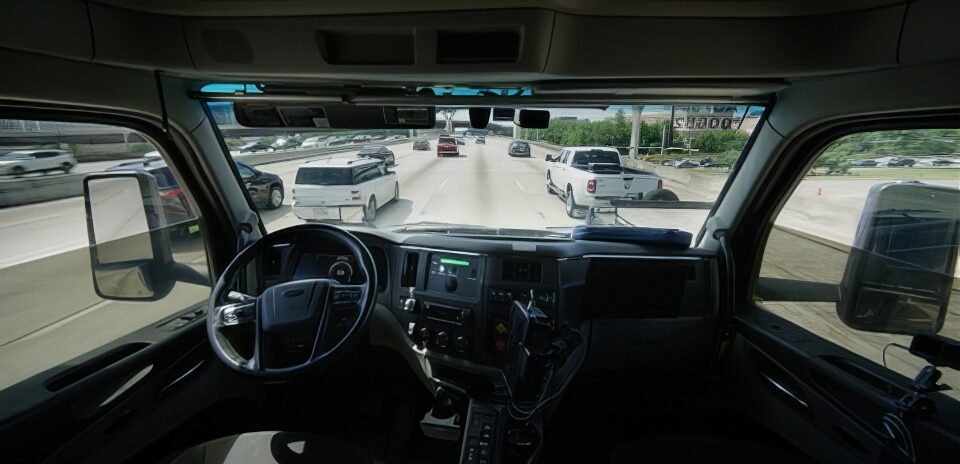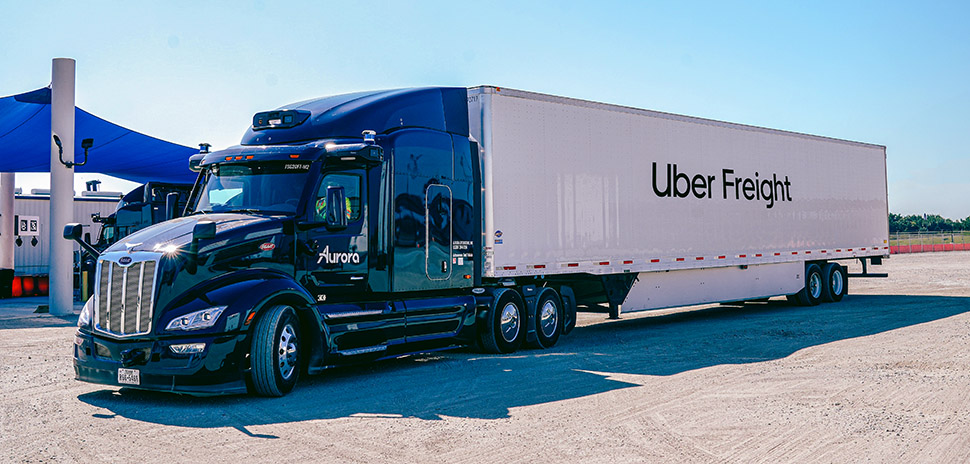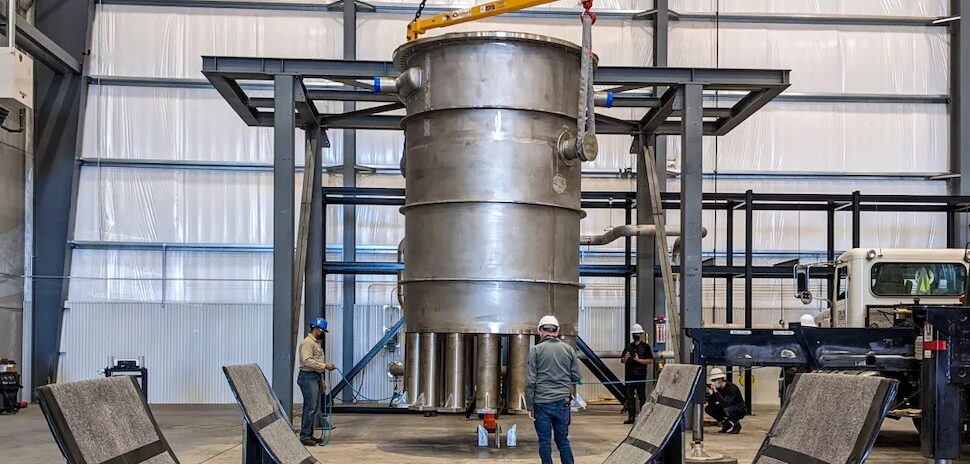Technology
“Six Little Dragons of Hangzhou” usher in new era of technological innovation | Smart Living | Technology
Published : 2025-05-09 Since the beginning of 2025, DeepSeek and the other five technology companies collectively known as the “Six Little Dragons” have attracted attention nationwide and even globally. All six companies are based in Hangzhou, but is this a coincidence or an inevitability? What are the reasons behind this? Hangzhou: from e-commerce centre to […]

Published : 2025-05-09
Since the beginning of 2025, DeepSeek and the other five technology companies collectively known as the “Six Little Dragons” have attracted attention nationwide and even globally.
All six companies are based in Hangzhou, but is this a coincidence or an inevitability? What are the reasons behind this?
Hangzhou: from e-commerce centre to innovation city
The “Six Little Dragons” refer to DeepSeek, Unitree Technology, Game Science, BrainCo, Qunhe Technology, Deep Robotics.
They all hail from Hangzhou and lead in cutting-edge fields such as artificial intelligence (AI), robotics, gaming technology, brain-machine interface, and the metaverse.
DeepSeek has launched the AI large model, which “achieves great results with small expenses”. Its reasoning ability rivals OpenAI’s ChatGPT4.0, promoting the popularization and application of AI technology.

Unitree Technology developed the Yangge dancing robot that caught everyone’s eye at the Spring Festival Gala, and its market share in the global quadruped robot market has approached 70%.
Game Science developed China’s first AAA game masterpiece “Black Myth: Wukong”.
BrainCo’s brain interface devices are a worthy match to Elon Musk’s Neuralink.
Qunhe Technology owns the world’s largest interactive 3D database, providing data support for smart home and robot training, among other things.
Deep Robotics’s quadruped bionic robotic dog can traverse mountains and waters and perform spins and jumps with ease. It has been purchased by the Singapore National Grid for tunnel patrol inspections and other tasks.
These six innovation and technology companies have risen to prominence, giving Hangzhou, the e-commerce capital, a new identity – the city of technological innovation.
Read more: Understanding DeepSeek|How does it challenge OpenAI? Who is the founder Liang Wenfeng?
Read more: Black Myth: Wukong|How does producer Feng Ji tell a Chinese story through a great work?

Hangzhou’s innovation and technology: genuine policy support
Why do these six innovation and technology companies all come from Hangzhou?
According to an article published by the Zhejiang Provincial Publicity Department, a strong industry relies on the concerted efforts of the government, enterprises, universities, and research institutes, with each playing its role and the innovation chain tightly linked.
At a city promotion meeting, Mayor Yao Gaoyuan expressed that Hangzhou supports enterprises with three aspects including: policy support with “genuine substance,” development investment with “real money,” and service guarantees with “genuine sincerity.”
First is the “genuine substance” of policy support.
Zhejiang Province is actively planning industries like quantum technology, synthetic biology, brain-computer interfaces, and future networks, with significant investments in technology, talent, and land.
For example, in 2017, they specially issued the “Robot+” action plan, becoming the first province in the nation to propose this policy.
It has been revealed that Hangzhou will create a tiered cultivation system of “technology-based SMEs — high-tech enterprises — emerging enterprise eagles — leading technology enterprises,” with the goal of developing over 2,000 national high-tech enterprises.
Read more: How much cutting-edge tech is in the 2025 Year of the Snake Spring Festival Gala?

Innovation and technology in Hangzhou: investment with “real money”
Second is the investment with “real money.”
To promote innovation and technology development, Hangzhou will implement the first batch of 145 provincial “1000 items and trillion projects” in 2025, with an annual planned investment of 89.6 billion RMB.
These funds and projects will boost support for future industries such as artificial intelligence, humanoid robots, intelligent logistics, and high-end equipment.
For example, the Yichuang Town in Xihu District, Hangzhou offers digital companies like Game Science a maximum of 100% rent subsidy or exemption within three years.
When Unitree Robotics faced a funding gap while developing quadruped robots in 2017, the Hangzhou government fund invested 20 million yuan and coordinated the sharing of Zhejiang University laboratory equipment, helping them overcome the technical bottleneck of motor drive technology.
As Yao Gaoyuan stated: “Regardless of financial tightness, we cannot cut down technology investment, ensuring that innovation always remains the city’s character.”

Innovation and technology in Hangzhou: service guarantees with “genuine sincerity”
The government plays an important role in providing policy and financial support, but it also needs to set boundaries to create an open and inclusive innovation ecosystem.
Hangzhou adheres to the principle of “serving when needed, not bothering when not,” making many technology enterprises successful.
The 2023 World Bank Business Environment Report shows that Hangzhou ranks 12th globally in contract enforcement efficiency, surpassing San Francisco at 19th, indicating that the government provides efficient services to enterprises.
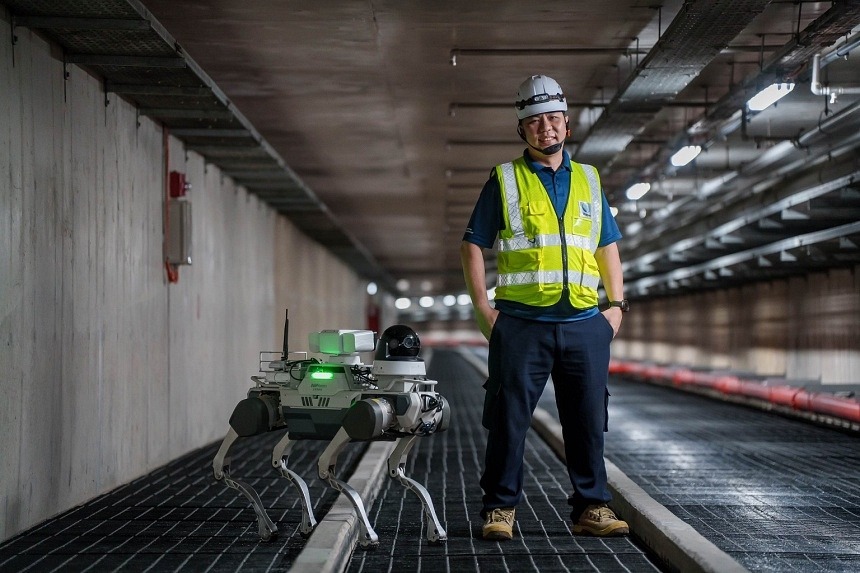
To attract talent, Hangzhou has launched multiple preferential measures in “clothing, food, housing, and transportation,” attracting over 300,000 undergraduates under 35 years old annually.
Major universities and local enterprises in the province are deeply bound, preventing the outflow of graduates from prestigious schools.
For instance, Zhejiang University established the nation’s first undergraduate AI major in 2018, and 40% of algorithm engineers at DeepSeek come from this major.
Zhu Qiuguo, founder of Deep Robotics, is a professor at Zhejiang University, and his team, relying on the Zhejiang University Robotics Institute, shortened the development cycle by 60%.
After years of efforts, Hangzhou’s net talent inflow rate has ranked first in the country for consecutive years, making it a preferred place for young people to start businesses and find employment.
Read more: Smart City|Hangzhou’s pioneering “City Brain” – What’s so amazing about it?
Technology
North Texas Company Partners with Aurora to Launch Autonomous Vehicle Workforce Program » Dallas Innovates
Volvo VNL Autonomous truck powered by Aurora Driver self-driving technology. [Photo: Aurora Innovation] Aurora Innovation made history in April as the first in the U.S. to transport goods on a U.S. highway with self-driving 18-wheelers—and not a single human aboard. Those historic runs between Dallas and Houston on I-45 could be a harbinger of much […]

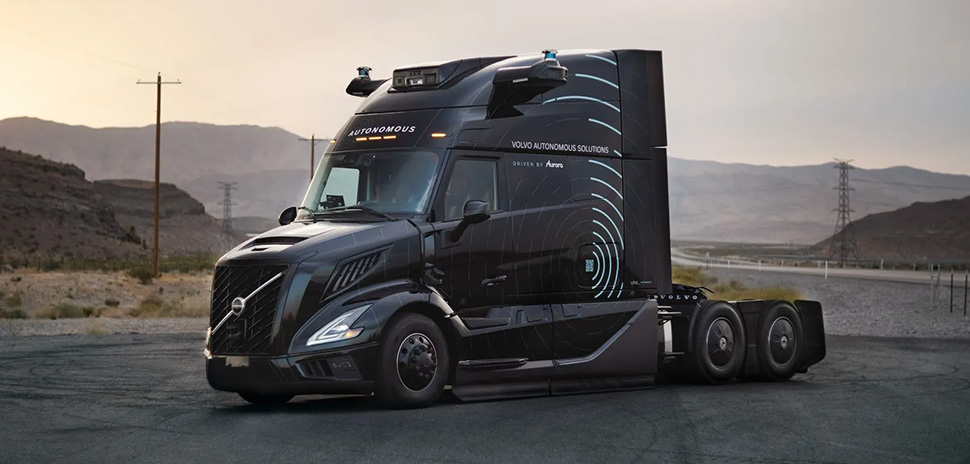
Volvo VNL Autonomous truck powered by Aurora Driver self-driving technology. [Photo: Aurora Innovation]
Aurora Innovation made history in April as the first in the U.S. to transport goods on a U.S. highway with self-driving 18-wheelers—and not a single human aboard. Those historic runs between Dallas and Houston on I-45 could be a harbinger of much more autonomous trucking to come. And now Aurora is partnering with Irving-based On the Road Garage to train workers to support the transition.
Pittsburgh, Pennsylvania-based Aurora (Nasdaq: AUR) later put observers back behind the wheel on the Dallas-Houston runs, at least temporarily, at the request of PACCAR, the manufacturer of Aurora’s Peterbilt and Kenworth trucks. But the trucking runs continue with the company’s Aurora Driver technology operating the vehicles.
Now On the Road Garage, which has two locations in Irving and Dallas, is partnering with Aurora by launching OTR Advanced Vehicle Technology—Powered by Aurora, “a cutting-edge apprenticeship and upskilling initiative designed to prepare workers from all backgrounds and experiences for high-growth careers in the autonomous vehicle (AV) industry.”

Photo: On the Road Garage
Aurora is advising the program, working with On the Road to co-create curriculum and training pathways that align with the evolving demands of various transportation industries. The training includes AV and electric vehicle repair, ADAS calibration, advanced vehicle technologies, and AV terminal operations, according to Champion Impact Capital, part of the On the Road family of businesses.
‘Creating a national model’

Michelle Corson
Champion was founded by On the Road Garage CEO Michelle Corson in 2013 to make investments in social enterprises. After forming On the Road Lending and On the Road Motors, the North Texas company launched On the Road Garage in Irving in 2020 as a tech-focused collision repair business to fill a skills gap and talent pipeline shortage.
“This program is about more than just jobs—it’s about building equitable access to the future of mobility,” On the Road VP Roy Villarreal said in a statement. “Through this collaboration with Aurora, we’re creating a national model for inclusive workforce development in emerging transportation technologies.”
The On the Road-Aurora training program combines hands-on training and pathways to industry credentials, the partners said, delivering learning experiences that mirror “the real-world demands” of the autonomous vehicle field. Participants in the program will be trained in skills needed for roles related to advanced diagnostics, sensor calibration, and vehicle repair.
Aurora to inform program’s technical curriculum
Aurora will inform the progam’s technical curriculum, the partners said, enabling apprentices to train on the self-driving vehicle platforms that have made history lately in Texas. The collaboration supports long-term goals around safety, scalability, and sustainability within the AV workforce ecosystem, the partners added.
“At Aurora, we’re not just building a business, we’re building an industry,” Aurora President Ossa Fisher said in a statement. “We’re proud to partner with On the Road Garage to build career pipelines that will not only train future transportation industry leaders, but prioritize inclusivity as new jobs are created to support autonomous trucking.”
The AV tech training program—which will be offered through On the Road Garage’s Apprenticeship program—will include opportunities for industry-recognized credentials, mentorship, and real-time skills assessment, which build on existing and well-established programs related to transportation and collision repair, On the Road said.
On the Road Garage provides advanced vehicle collision repair and advanced driver assistance systems (ADAS) calibration along with “technology-forward” apprenticeships and training. The company said it’s dedicated to programs “that drive economic mobility to address transportation challenges and equip the next generation of automotive technicians.”
Don’t miss what’s next. Subscribe to Dallas Innovates.
Track Dallas-Fort Worth’s business and innovation landscape with our curated news in your inbox Tuesday-Thursday.
Technology
Wearable fitness trackers can make you seven times more likely to stick to your workouts: New research
Credit: CC0 Public Domain The hardest part of any workout regime is sticking with it. Around half of those who start an exercise program stop within six months. But our recent study found that using wearables (such as a smartwatch) not only makes people more likely to start working out, they’re also seven times more […]

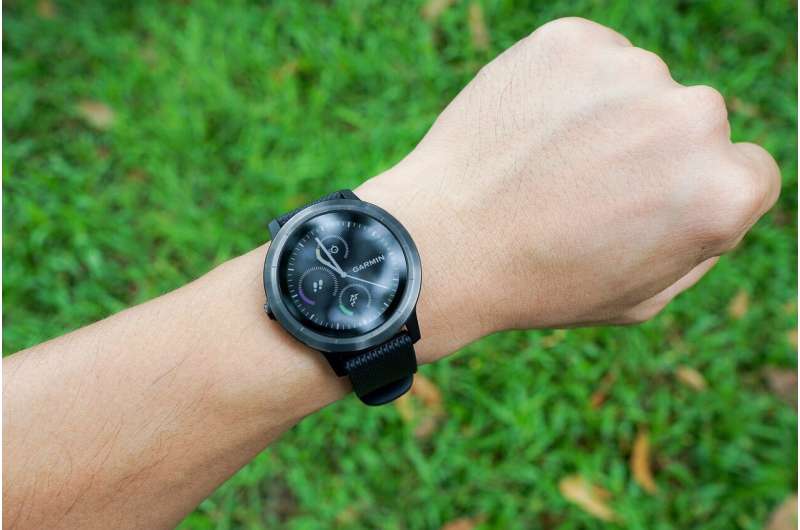
The hardest part of any workout regime is sticking with it. Around half of those who start an exercise program stop within six months.
But our recent study found that using wearables (such as a smartwatch) not only makes people more likely to start working out, they’re also seven times more likely to still be active after six months compared to those who didn’t use a smartwatch.
Our study focused specifically on adults who had recently been diagnosed with type 2 diabetes. Physical activity is a cornerstone of type 2 diabetes management, as it helps regulate blood sugar, supports cardiovascular health and improves quality of life.
Yet around 90% of people with type 2 diabetes fall short of weekly physical activity recommendations. Common barriers include low motivation, uncertainty about what activity is safe and a lack of tailored support.
Our study tested a new approach using wearable technology and remote coaching to overcome these barriers. We found that people who followed a smartwatch-supported remote coaching program were ten times more likely to start a workout regime than those who received remote coaching alone.
The study involved 125 adults aged between 40 and 75 from the UK and Canada who had recently been diagnosed with type 2 diabetes. All participants worked with an exercise specialist to co-design a personalized six-month physical activity plan. The focus was on gradually increasing both moderate-to-vigorous exercise (with a target of 150 minutes per week) and daily lifestyle activity. Support was delivered remotely through phone or video calls.
Half of the participants were randomly assigned to use wearable technology to support their personalized activity plans. The smartwatch had movement and heart rate sensors, a mobile app to track activity and personalized text messages based on their recent progress. They could also message their coach, receive real-time feedback and adjust their activity plans accordingly.
The results were striking. Compared to the control group, those who were given a smartwatch were ten times more likely to start working out regularly, seven times more likely to still be active after six months and three times more likely to remain active one year later—even after support had ended.
At the end of the program, over 50% of the smartwatch group were meeting recommended activity levels. In comparison, only 17% of the control group were.
Feedback from participants showed that the flexibility of plans, personalized messages and smartwatch data were key motivators. While some faced early challenges with the technology, most adapted quickly.
These findings support growing evidence that wearable technology can help people become—and stay—more active. While our study focused on people with type 2 diabetes, similar benefits have also been observed in the general population.
For example, one trial found that inactive adults (aged 45–75) who were given pedometers and walking advice increased their daily step count by around 660 steps after 12 weeks compared to a control group. Those given a pedometer were also more active three years later.
Since then, wearable technology has advanced. Modern smartwatches now capture a wider range of metrics beyond steps—such as heart rate and activity intensity. A 2022 systematic review and meta-analysis, which analyzed more than 160 randomized controlled trials, found that fitness trackers and similar devices were effective at increasing physical activity by an average of around 1,800 steps per day. Importantly, the most sustained improvements occurred when wearables were paired with personalized feedback or behavioral support.
Together, these studies suggest that wearables can be powerful tools for long-term behavior change and may help us better stick to our fitness goals.
Wearable fitness trackers can be extremely helpful—but only if you use them purposefully. Our research, along with findings from other studies, shows that wearables are most effective when they help you apply proven behavior-change strategies.
Here are some evidence-based tips to help you get the most out of your device:
1. Set realistic, specific goals
Plan exactly when and how you’ll move. Apps can help you set daily or weekly targets. Research shows that breaking down big, vague intentions—such as “get fit”—into small, concrete steps makes it easier to stay motivated and avoid feeling overwhelmed.
2. Schedule activity and stick to it
Use reminders or calendar prompts to build a regular routine. Consistency builds habits, and scheduled activity reduces the chance of skipping workouts due to forgetfulness or lack of planning.
3. Track your progress
Monitoring your activity helps you stay motivated and accountable. This feedback boosts motivation by showing that your efforts are making a difference, increasing your sense of control and accountability.
4. Use small rewards
Many devices include features such as badges or streaks, which reinforce progress. Celebrating small wins triggers feelings of accomplishment, which encourages you to keep going and helps build long-term habits.
5. Share with others
Whether it’s a friend or coach, sharing your progress can boost commitment. Knowing others are aware of your goals can increase motivation, provide encouragement, and help you overcome challenges.
6. The tracker is a tool, not the solution
It won’t change behavior on its own. Its value lies in how it supports your goals and helps you build lasting habits.
These techniques don’t just encourage short-term change—they build motivation, self-belief and routine, which are key for maintaining healthy habits over time.
Our research shows that when wearable tech is used as part of a structured, supportive program, it can make a real difference—especially for people managing health conditions such as type 2 diabetes. By combining wearable technology with personalized coaching and proven behavior change techniques, you might just have a better chance of sticking with your physical activity goals.
The Conversation
This article is republished from The Conversation under a Creative Commons license. Read the original article.![]()
Citation:
Wearable fitness trackers can make you seven times more likely to stick to your workouts: New research (2025, June 12)
retrieved 12 June 2025
from https://medicalxpress.com/news/2025-06-wearable-trackers-workouts.html
This document is subject to copyright. Apart from any fair dealing for the purpose of private study or research, no
part may be reproduced without the written permission. The content is provided for information purposes only.
Technology
Europe Luxury & Sports Cars Market Size, Share, Growth Trends,
luxury sports cars market “ The Luxury & Sports Cars market is undergoing a period of dynamic expansion, fueled by a confluence of factors including burgeoning disposable incomes in emerging economies, rapid technological advancements in automotive engineering, and an increasing consumer desire for personalized and high-performance vehicles. These vehicles are no longer solely symbols of […]


luxury sports cars market
“
The Luxury & Sports Cars market is undergoing a period of dynamic expansion, fueled by a confluence of factors including burgeoning disposable incomes in emerging economies, rapid technological advancements in automotive engineering, and an increasing consumer desire for personalized and high-performance vehicles. These vehicles are no longer solely symbols of status, but increasingly represent technological prowess and a commitment to sustainable performance. Electrification is rapidly transforming the sector, with hybrid and fully electric models gaining significant traction, driven by stringent emissions regulations and growing environmental awareness. Furthermore, the integration of advanced driver-assistance systems (ADAS), cutting-edge infotainment, and connectivity features is enhancing the driving experience and attracting a tech-savvy consumer base. The market also plays a crucial role in addressing global challenges by pushing the boundaries of automotive innovation, particularly in areas such as fuel efficiency, safety, and autonomous driving. This constant evolution and commitment to excellence position the luxury and sports car market as a key indicator of broader automotive industry trends and a significant contributor to global economic growth.
Get the full PDF sample copy of the report: (TOC, Tables and figures, and Graphs) https://www.consegicbusinessintelligence.com/request-sample/2693
Market Size:
The Luxury & Sports Cars Market size is estimated to reach over USD 1,054.53 Billion by 2032 from a value of USD 652.43 Billion in 2024. The market is projected to grow by USD 681.44 Billion in 2025, growing at a CAGR of 6.7% from 2025 to 2032.
Definition of Market:
The Luxury & Sports Cars market encompasses the production, distribution, and sale of high-end automobiles designed to provide superior levels of comfort, performance, and exclusivity. This market segment is characterized by vehicles that offer advanced technologies, premium materials, and distinctive styling. The market includes a range of vehicle types, from high-performance sports cars designed for speed and agility to luxurious sedans offering unparalleled comfort and refinement.
Key terms associated with this market include:
Luxury Car: Vehicles offering a high level of comfort, features, and quality beyond that of standard automobiles. They often include premium materials, advanced technology, and enhanced performance capabilities.
Sports Car: Vehicles designed with a focus on performance, handling, and driver engagement. They typically feature powerful engines, responsive steering, and aerodynamic designs.
Supercar: A high-performance sports car, often with limited production runs, offering extreme levels of speed, handling, and exclusivity.
Hybrid Vehicle: A vehicle that combines a traditional internal combustion engine with an electric motor and battery system to improve fuel efficiency and reduce emissions.
Electric Vehicle (EV): A vehicle powered solely by an electric motor and battery system, producing zero tailpipe emissions.
Autonomous Driving: Technology that allows vehicles to operate with minimal or no human intervention. It is often implemented through Advanced Driver Assistance Systems (ADAS).
Get Discount On Report @ https://www.consegicbusinessintelligence.com/request-discount/2693
Market Scope and Overview:
The Luxury & Sports Cars market spans a wide range of technologies, applications, and industries. This market includes the design, engineering, manufacturing, and sales of vehicles equipped with advanced features such as cutting-edge engine technology, sophisticated suspension systems, advanced driver-assistance systems (ADAS), and premium interior finishes. The applications of these vehicles extend beyond personal transportation to include motorsports, luxury travel, and high-performance driving experiences. The industries served by this market encompass automotive manufacturers, suppliers of components and materials, dealerships, aftermarket service providers, and technology companies specializing in automotive innovation.
The Luxury & Sports Cars market plays a vital role in the larger context of global automotive trends. It drives innovation in areas such as electrification, autonomous driving, and connectivity, which eventually permeate the broader automotive market. This market sets benchmarks for performance, safety, and luxury, influencing consumer expectations and technological development across the entire automotive industry. Furthermore, the demand for luxury and sports cars reflects underlying economic trends and consumer preferences, making it a key indicator of overall market health and societal priorities. As global awareness of environmental sustainability grows, the luxury and sports car market is also responding by embracing electrification and developing eco-friendly materials and manufacturing processes. This demonstrates the market’s capacity to adapt and lead in the face of evolving societal demands and environmental concerns.
Top Key Players in this Market
Audi (Germany) BMW (Germany) Cadillac (U.S.) Genesis (South Korea) Jaguar Land Rover (U.K.) Lexus (Japan) Maserati (Italy) Mercedes-Benz (Germany) Porsche (Germany) Volvo (Germany)
Market Segmentation:
The Luxury & Sports Cars market can be segmented in the following ways:
By Vehicle Type: This segment includes SUVs, Sedans/Hatchbacks, and Sports/Super Luxury Cars. SUVs are gaining popularity for their combination of luxury and practicality. Sedans/Hatchbacks offer a balance of comfort and performance, while Sports/Super Luxury Cars focus on high performance and exclusivity.
By Propulsion: This segment is divided into Electric/Hybrid and ICE (Internal Combustion Engine) vehicles. Electric/Hybrid vehicles are experiencing rapid growth due to increasing environmental awareness and government incentives. ICE vehicles still hold a significant share but are gradually being replaced by more sustainable options.
By Component: This segment includes Drivetrain, Interior, Body, Electronics, and Chassis. Each component plays a crucial role in the performance, comfort, and safety of luxury and sports cars. Innovations in each of these areas contribute to the overall market growth.
Market Drivers:
Technological Advancements: Continuous innovation in engine technology, materials science, and electronic systems is driving the development of more powerful, efficient, and safer luxury and sports cars.
Government Policies: Stringent emissions regulations and incentives for electric vehicles are encouraging manufacturers to invest in hybrid and electric models.
Increasing Demand for Sustainability: Growing consumer awareness of environmental issues is driving demand for electric and hybrid luxury and sports cars.
Rising Disposable Incomes: Increasing wealth, especially in emerging markets, is enabling more consumers to afford luxury and sports cars.
Desire for Personalized Experiences: The ability to customize and personalize vehicles to individual tastes is a major draw for luxury car buyers.
Market Key Trends:
Electrification: The shift towards electric and hybrid powertrains is transforming the luxury and sports car market.
Autonomous Driving: The integration of advanced driver-assistance systems (ADAS) is making luxury and sports cars safer and more convenient to drive.
Connectivity: The increasing integration of connectivity features, such as over-the-air updates and smartphone integration, is enhancing the ownership experience.
Personalization: Manufacturers are offering a wider range of customization options to cater to individual consumer preferences.
Focus on Sustainability: A growing emphasis on sustainable materials and manufacturing processes is becoming increasingly important.
Market Opportunities:
Expansion in Emerging Markets: Untapped potential in countries with rapidly growing economies and increasing disposable incomes.
Development of Advanced Technologies: Opportunities to innovate in areas such as autonomous driving, electrification, and connectivity.
Customization and Personalization: Expanding the range of customization options to cater to individual consumer preferences.
Subscription Services: Offering subscription-based access to luxury and sports cars can attract a wider range of customers.
Sustainable Materials and Manufacturing: Investing in eco-friendly materials and production processes can appeal to environmentally conscious consumers.
Market Restraints:
High Initial Costs: The high price of luxury and sports cars can be a barrier to entry for many consumers.
Stringent Regulations: Increasingly strict emissions and safety regulations can increase the cost of development and production.
Economic Uncertainty: Economic downturns can negatively impact demand for luxury goods, including luxury and sports cars.
Infrastructure Limitations: The lack of charging infrastructure for electric vehicles can limit their adoption in some regions.
Geographic Limitations: Demand for certain types of luxury and sports cars may be limited in some regions due to factors such as climate and road conditions.
Market Challenges:
The Luxury & Sports Cars market faces a multifaceted array of challenges that demand strategic adaptation and innovative solutions from industry players. One of the most significant challenges is the escalating pressure to meet increasingly stringent environmental regulations, particularly concerning emissions and fuel efficiency. Manufacturers are compelled to invest heavily in the development of electric and hybrid powertrains, as well as lightweight materials, to comply with these regulations while maintaining the performance and driving experience that define luxury and sports cars. This necessitates substantial R&D expenditures and a shift in manufacturing processes, which can impact profitability.
Another critical challenge is managing the supply chain disruptions that have become increasingly prevalent in recent years. Shortages of semiconductors and other essential components have disrupted production schedules and increased costs, impacting the ability of manufacturers to meet demand. Building resilient and diversified supply chains is essential to mitigate these risks, but it requires significant investment and strategic partnerships.
Furthermore, the market is facing evolving consumer expectations and preferences. Younger generations of buyers are placing greater emphasis on sustainability, connectivity, and personalized experiences. Manufacturers must adapt their products and services to cater to these changing demands, which requires a deeper understanding of consumer behavior and a willingness to embrace new technologies and business models. This includes offering a wider range of customization options, integrating advanced connectivity features, and exploring alternative ownership models such as subscription services.
Competition is also intensifying, with new entrants from the electric vehicle sector challenging established luxury car brands. These new players are often more agile and innovative, and they are disrupting the market with their focus on electric powertrains, advanced technology, and direct-to-consumer sales models. To remain competitive, established manufacturers must embrace innovation, streamline their operations, and differentiate their products and services through superior quality, performance, and brand reputation.
Finally, the market is grappling with the ethical and social implications of autonomous driving technology. Ensuring the safety and reliability of autonomous systems is paramount, and manufacturers must address concerns about data privacy, cybersecurity, and the potential displacement of human drivers. This requires collaboration with regulators, technology companies, and other stakeholders to develop robust standards and regulations that promote responsible innovation and public trust.
Market Regional Analysis:
The Luxury & Sports Cars market exhibits diverse dynamics across different regions, influenced by unique economic, social, and regulatory factors. North America and Europe have historically been major markets for luxury vehicles, driven by high disposable incomes and a strong preference for premium brands. However, stricter emissions regulations and growing environmental awareness are accelerating the adoption of electric and hybrid models in these regions.
The Asia-Pacific region, particularly China, represents a significant growth opportunity for the Luxury & Sports Cars market. The rapid economic growth in these countries has led to a surge in demand for luxury goods, including high-end automobiles. In addition, the Asia-Pacific market presents specific tastes and needs, such as a higher preference for chauffeur-driven experiences and longer wheelbases, leading to customized models catered to these regional needs.
Other regions, such as the Middle East and Latin America, also offer potential for growth, albeit with unique challenges. The Middle East is characterized by a strong preference for high-performance vehicles and a willingness to spend on luxury goods. Latin America, on the other hand, is more price-sensitive and faces economic instability, which can impact demand for luxury vehicles. Understanding these regional nuances is crucial for manufacturers to develop effective market entry and growth strategies.
Frequently Asked Questions:
What is the projected growth of the Luxury & Sports Cars market?
The Luxury & Sports Cars market is projected to grow at a CAGR of 6.7% from 2025 to 2032, reaching over USD 1,054.53 Billion by 2032.
What are the key trends driving growth in this market?
Key trends include the increasing adoption of electric and hybrid powertrains, the integration of advanced driver-assistance systems, and the growing demand for personalized vehicles.
What are the most popular Market types?
The most popular Market types include SUVs, Sedans, and Sports Cars, each catering to different consumer preferences and needs.
Follow us on:
https://www.linkedin.com/company/tech-futures-forum/
https://www.linkedin.com/company/trend-realm/
https://www.linkedin.com/company/data-trail-mru/
https://www.linkedin.com/company/insight-grid/
https://www.linkedin.com/company/digital-disruption-digest/“
Contact Us:
Consegic Business intelligence Pvt Ltd
Baner Road, Baner, Pune, Maharashtra – 411045
(US) (505) 715-4344
info@consegicbusinessintelligence.com
sales@consegicbusinessintelligence.com
Web – https://www.consegicbusinessintelligence.com/
About Us:
Consegic Business Intelligence is a data measurement and analytics service provider that gives the most exhaustive and reliable analysis available of global consumers and markets. Our research and competitive landscape allow organizations to record competing evolutions and apply strategies accordingly to set up a rewarding benchmark in the market. We are an intellectual team of experts working together with the winning inspirations to create and validate actionable insights that ensure business growth and profitable outcomes.
We provide an exact data interpretation and sources to help clients around the world understand current market scenarios and how to best act on these learnings. Our team provides on-the-ground data analysis, Portfolio Expansion, Quantitative and qualitative analysis, Telephone Surveys, Online Surveys, and Ethnographic studies. Moreover, our research reports provide market entry plans, market feasibility and opportunities, economic models, analysis, and an advanced plan of action with consulting solutions. Our consumerization gives all-inclusive end-to-end customer insights for agile, smarter, and better decisions to help business expansion.
Connect with us on:
LinkedIn – https://www.linkedin.com/company/consegic-business-intelligence/
YouTube – https://www.youtube.com/@ConsegicBusinessIntelligence22
Facebook – https://www.facebook.com/profile.php?id=61575657487319
X – https://x.com/Consegic_BI
Instagram – https://www.instagram.com/cbi._insights/
This release was published on openPR.
Technology
Ballers Closes $20M Series A, Announces Opening of Flagship ‘Social Sports Venue’ in Philadelphia
David Gutstadt Ballers has closed a $20 million Series A co-led by specialized New York venture firms Sharp Alpha and RHC Group, as it announced the opening of its first “social sports venue” in Philadelphia, the headquarters of the company building hospitality-driven centers across the country. The creative startup — started by Equinox veterans and […]


David Gutstadt
Ballers has closed a $20 million Series A co-led by specialized New York venture firms Sharp Alpha and RHC Group, as it announced the opening of its first “social sports venue” in Philadelphia, the headquarters of the company building hospitality-driven centers across the country.
The creative startup — started by Equinox veterans and Fitler Club founders David Gutstadt and Amanda Potter, who are married to each other, and Vero Capital founder Daniel Bassichis — has also won the backing of high-profile athletes and celebrities. Tennis icons Andre Agassi, Kim Clijsters and Sloane Stephens; the world No. 3 singles pickleball player Connor Garnett, MLS star and padel aficionado Maarten Paes, and Philadelphia 76ers owner David Blitzer were among those who joined the investment round.
“Having played tennis in college, racquet sports have always been a passion of mine. So when we saw the opportunity to marry the powerful trend and innovations in urban social sports including pickleball, padel and golf with our unique expertise in design and community-building, we went all in on Ballers,” said Gutstadt, who serves as Ballers’ CEO. “The incredible response to our Philadelphia pop-up last year showed us that people are craving this connection through sports, and we’re excited to show that when paired with unparalleled hospitality, athletics can go beyond just leagues, lessons or court time.”
Potter, who serves as the company’s chief creative officer, underlined the point that Ballers is not just a sports facility, adding that “we’re merging sport and culture, creating a social hub for fashion, art and community.”
Ballers says it is bringing “country club sports to the city.” Its centers will have pickleball, padel, golf, squash and soccer, along with food and beverages and dynamic event spaces, among other facilities. It has picked sites ranging from decommissioned power plants to downtown rooftops. Ballers’ Philadelphia site is located at the Turbine Hall space of The Battery in Fishtown, and will sport six pickleball courts, three padel courts, four golf simulators, fitness and recovery spaces, and food and beverage service.
Ballers plans launches in Boston in August and in Miami either in the last quarter or early next year. Over the next 7-10 years, it expects to open over 50 locations, including Los Angeles, New York, Washington, D.C., Chicago, Connecticut and Toronto.
“Consumers are prioritizing meaningful shared experiences and lasting connections,” said Lloyd Danzig, managing partner of Sharp Alpha. “Competition is the fastest-growing centerpiece for socialization. Modern urban country clubs sit right at the intersection of these trends.”
RHC Group founder Richard Hsiao said he doesn’t see his backing as just an investment in racquet sports, but as “an investment in a new business model that seeks to channel how active consumers want to play and be entertained, all while keeping true to the cities and neighborhoods that make their experiences unique.”
Technology
The Latest on Apple Watch: watchOS 26 and What’s Coming in Fall 2025
Apple is doubling down on the Apple Watch as not just a smartwatch, but a full-fledged AI-powered health and productivity companion. With watchOS 26 officially unveiled at WWDC 2025, and major hardware upgrades on the horizon for Series 11 and Ultra 3, the Apple Watch is entering a new era. Here’s everything you need to […]

Apple is doubling down on the Apple Watch as not just a smartwatch, but a full-fledged AI-powered health and productivity companion. With watchOS 26 officially unveiled at WWDC 2025, and major hardware upgrades on the horizon for Series 11 and Ultra 3, the Apple Watch is entering a new era. Here’s everything you need to know.
A Revamped Interface: “Liquid Glass” Design
One of the most visible changes in watchOS 26 is the new Liquid Glass UI, bringing a semi-translucent aesthetic to match iOS 26 and macOS Sequoia. This design introduces smoother animations, layered depth, and a more unified Apple ecosystem feel across devices.

This visual overhaul makes interacting with the Apple Watch feel more premium and fluid—especially on newer OLED displays.
Workout Buddy: Apple Intelligence Comes to Fitness
Apple is injecting its AI suite, Apple Intelligence, into the Apple Watch experience with a new feature called Workout Buddy. This AI-powered coach offers real-time feedback during activities like running, weight training, and cycling.

Instead of generic data dumps, you get motivational prompts, dynamic adjustments based on your pace or fatigue, and personalized coaching via Bluetooth audio using natural-sounding voices. This feature makes your watch feel more like a personal trainer than ever before.
Smart Stack 2.0 and Expanded Widgets
watchOS 26 enhances Smart Stack with more context-aware cards. Widgets now adapt in real time—showing weather when rain is incoming or bringing up your boarding pass right before a flight. For the first time, third-party developers can build widgets that appear in the stack, giving the platform broader utility.

The Control Center has also been redesigned to be swipe-accessible from anywhere, not just the watch face, reducing taps and improving speed of access.
New Gestures and Better Accessibility

A standout addition is the new “wrist flick” gesture, which lets you dismiss notifications with a subtle motion. This builds on Apple’s existing AssistiveTouch features and reflects a broader push for one-handed usability—especially during workouts or when on the go.
Messaging and Translation Upgrades

Messaging gets smarter in watchOS 26. You can now live-translate messages in over a dozen languages directly on the wrist, ideal for travel or international chats. The Messages app also receives UI enhancements and more quick-reply suggestions powered by Apple Intelligence.
Apple Notes Finally Arrives on Watch
For the first time, Apple Notes is available as a native app on the Apple Watch. You can view, edit, and create short notes on the fly, with dictation and voice input making note-taking hands-free.

Smarter Music During Workouts
Apple is leaning into personalized media integration: the Workout app now auto-selects music playlists based on your past habits and workout type. Whether it’s pump-up playlists for cardio or chill tracks for yoga, your wrist now doubles as your DJ.

Release Timeline
- Developer Beta launched June 9, 2025
- Public Beta expected in July
- General Release: Mid–September 2025, likely tied to new hardware reveals
Looking Ahead: Apple Watch Series 11 & Ultra 3 (Fall 2025)
With the software refresh underway, all eyes now turn to Apple’s next hardware generation.
Apple Watch Series 11
Expected alongside iPhone 17 in September 2025, the Series 11 may finally debut:
- Micro-LED displays: Offering brighter colors, better energy efficiency, and longer lifespan than OLED
- New S11 chip: Promising faster performance and smoother animations
- Health sensors: Blood pressure monitoring, possible non-invasive glucose tracking, and improved ECG
Apple is reportedly still navigating legal hurdles around SpO₂ sensors, but plans to return full oxygen monitoring once cleared.
Apple Watch Ultra 3
Apple’s Ultra model continues to push boundaries, and Ultra 3 could bring:
- Satellite messaging: Great for backcountry or remote travel
- Bluetooth 5G/5G RC: A low-power variation of 5G for wearable-friendly communication
- Experimental sensors: Apple may use Ultra 3 as a testbed for emerging features like hydration tracking or advanced body temp sensing
Some leaks even hint at a wrist camera prototype being tested internally—though that feature may be reserved for future models beyond 2025.
Should You Upgrade?
If you already own a Series 9, 10, or Ultra 2, you’ll get most of the new watchOS 26 features this fall, especially the design update and AI-powered coaching. But if you’re looking for serious health innovations, display advancements, or extreme sports functionality, waiting for Series 11 or Ultra 3 is a smart move.

Apple is clearly positioning the Apple Watch not just as an accessory—but as a full-fledged AI-powered health, communication, and lifestyle device. With watchOS 26 laying the groundwork and hardware upgrades on the way, 2025 is shaping up to be the most ambitious year yet for Apple’s wearable lineup.
Latest About The Apple Watch Series 10 (2024)
Apple has released its newest smartwatch, the Apple Watch Series 10, marking a significant milestone for the popular wearable device. The Series 10 features the largest display ever seen on an Apple Watch, allowing users to view more information at a glance than previous models. This redesigned watch continues Apple’s tradition of refining both the aesthetics and functionality of their devices.
The Apple Watch Series 10 represents the biggest update to Apple’s wearable line in 2024, bringing enhanced capabilities and a refined design to the world’s most popular smartwatch. For those considering an upgrade or first-time purchase, the Series 10 offers compelling improvements over previous generations. Apple unveiled this new model in September 2024, positioning it as their flagship watch alongside the more rugged Ultra 2 model.
As we move toward 2025, potential buyers face choices between the new Series 10 and other models like the Ultra 2 or the more affordable SE. The Series 10’s technical specifications and design changes make it a noteworthy contender in the increasingly competitive smartwatch market.
Here’s a rundown of the latest about the Apple Watch Series 10:
Design and Display:
- Thinner and Lighter: The Series 10 is Apple’s thinnest and lightest Apple Watch to date, with a depth of 9.7mm for both sizes.
- Larger Displays: It comes in larger case sizes of 42mm and 46mm, offering a significantly larger display area (up to 9% more than Series 7/8/9, and 30% more than Series 4/5/6).
- Enhanced Always-On OLED Display: The wide-angle OLED display is up to 40% brighter when viewed at an angle and has a faster refresh rate in always-on mode, allowing for a continuously ticking second hand.
- New Finishes: Aluminum models are available in Silver, Jet Black (a new polished black finish), and Rose Gold. The new titanium option (replacing stainless steel) comes in Natural, Gold, and Slate Grey, and is about 20% lighter than the stainless steel Series 9.
- Redesigned Speaker Grille: A new micro-perforated speaker grille is on the left side of the watch.
Health and Fitness Features:
- Sleep Apnea Detection: A significant new health feature, it uses accelerometer data to detect sleep disturbances that may indicate sleep apnea.
- Vitals App: Provides a quick overview of key overnight health metrics like heart rate, respiratory rate, wrist temperature, and sleep duration.
- Improved Water Resistance: While still 50m water resistant, it now includes a depth gauge (up to 6 meters) and water temperature sensors, previously exclusive to the Apple Watch Ultra. It also integrates the Oceanic+ app for snorkeling.
- Enhanced Workout Features: Offers new metrics like Training Load to help users understand the intensity of their workouts and avoid overtraining. You can also create custom workouts.
- Existing Health Features: Continues to offer ECG, high/low heart rate notifications, irregular rhythm notifications, Cycle Tracking with retrospective ovulation estimates, Fall Detection, and Crash Detection. (Note: Blood oxygen detection is currently disabled on watches sold in the US due due to a patent dispute.)
Performance and Battery:
- S10 SiP: Features a new S10 SiP (System in Package) with a 64-bit dual-core processor and a 4-core Neural Engine for improved machine learning tasks and on-device Siri. The S10 SiP is single-sided, contributing to the thinner design.
- Faster Charging: Boasts 20% faster charging, reaching 80% battery in about 30 minutes.
- All-Day Battery Life: Maintains the “all-day” battery life of up to 18 hours in normal use, and up to 36 hours in Low Power Mode.
Other Notable Features:
- On-Device Siri: Siri processing is now handled directly on the device.
- Precision Finding: Helps locate your iPhone with distance and direction indicators.
- Audio Playback through Speaker: You can now play music and podcasts directly through the Apple Watch speaker, not just calls.
- Translation App: Integrates Apple’s Translate app with the ability to download languages for offline use.
- watchOS 11: Ships with watchOS 11, bringing features like pausing Activity Rings, Check In, and enhanced Smart Stack organization.
Overall, the Apple Watch Series 10 represents a significant refresh in terms of design (thinner, lighter, larger display) and introduces valuable health and fitness features, particularly for sleep tracking and water activities.
Key Takeaways
- Apple Watch Series 10 features the largest display ever in the product line with a refined design.
- The new watch was released in September 2024 as Apple’s flagship smartwatch model.
- Consumers can choose between the Series 10, Ultra 2, and SE models based on their needs and budget.
Design and Build of the New Apple Watch 2024 Editions
Apple has made significant strides in refining the design of its latest watch offerings for 2024. The Series 10 represents a major milestone with its expanded display and refined aesthetics, while maintaining the brand’s commitment to durability and style.
Material Enhancements and Variety
The 2024 Apple Watch lineup showcases impressive material improvements across all models. Series 10 features a premium titanium option that offers exceptional durability while remaining lightweight. This high-end material, previously reserved for Ultra models, now gives standard Series users access to this premium finish.
Aluminum remains a popular choice for the Series 10 and SE models, offering a balance of affordability and durability. The aluminum cases have been refined with improved scratch resistance compared to previous generations.
The Apple Watch Ultra 2 now comes in a striking jet black titanium finish, adding a sophisticated option to the adventure-focused model. This new color joins the existing titanium options, giving users more personalization choices for the rugged Ultra line.
Display Innovations
Series 10 boasts “the biggest and most advanced display yet” according to Apple. The expanded screen real estate allows for more information to be displayed simultaneously, enhancing user experience. The always-on Retina display features improved brightness for better outdoor visibility.
The active display area has been increased by reducing bezel size, providing more usable screen without significantly increasing the watch’s overall dimensions. This engineering achievement maintains comfort while maximizing screen space.
The Ultra models continue to feature the wide-angle OLED display that provides exceptional clarity even in challenging lighting conditions. The display’s enhanced durability makes it ideal for outdoor adventures and extreme sports.
Size, Shape, and Color Options
Apple has maintained its commitment to providing various case sizes to suit different wrist sizes and preferences. The Series 10 offers multiple size options, with the larger display models attracting users who prioritize screen real estate for easier reading and interaction.
Color options have expanded across the lineup. The aluminum models come in silver, rose gold, and other finishes that complement various bands and personal styles. The new jet black option for the Ultra 2 adds a sleek, professional look to the adventure-focused watch.
The SE maintains its position as an affordable entry point with a streamlined selection of finishes, including silver aluminum. Each model maintains Apple’s distinctive rounded square shape that has become iconic in the smartwatch market.
Tech Advancements and Feature Integrations
Apple’s upcoming 2024 watch lineup showcases significant technological improvements focused on performance, health monitoring, and user experience. The new models incorporate advanced sensors and processing capabilities to deliver more accurate data and faster response times.
Enhanced Health and Fitness Capabilities
The 2024 Apple Watch models are expected to feature expanded health monitoring systems. A major addition is sleep apnea detection, which will use existing sensors to monitor breathing patterns during sleep and alert users to potential issues. This builds upon Apple’s established sleep tracking features.
The ECG app continues to receive refinements for more accurate heart rhythm assessments. Blood oxygen monitoring also remains a key feature, though regulatory challenges have affected its availability in some regions.
Temperature sensors now provide more precise readings with improved algorithms. For fitness enthusiasts, the watches offer enhanced workout metrics and more accurate GPS tracking during outdoor activities.
Apple has also improved the fitness tracker algorithms to better detect various workout types automatically. These enhancements make the new watches more effective health companions for daily use.
Improved Performance and Battery Life
The new S10 SiP (System in Package) represents a significant upgrade from the previous S9 chip. Early reports suggest processing speeds up to 20% faster, enabling smoother app performance and more responsive interfaces.
Battery life has received notable attention, with the Series 10 featuring a redesigned metal back that integrates a larger and more efficient charging coil. This makes it “the fastest-charging Apple Watch ever,” reducing downtime between uses.
Low Power Mode has been enhanced to preserve more functionality while extending battery life. GPS battery life specifically has improved, making the watch more practical for long outdoor activities without requiring a recharge.
The Neural Engine in the S10 chip enables more on-device processing, including on-device Siri capabilities that reduce reliance on the paired iPhone and improve response times for voice commands.
Exclusive Features for Diverse Use Cases
The Ultra line continues to target outdoor enthusiasts with specialized features. The rumored Ultra 3 may be approximately 15% thinner while maintaining its rugged build quality and featuring a larger display.
Water resistance remains exceptional across the lineup, with diving features on the Ultra models including the depth gauge and water temperature sensor for underwater activities.
The dual-frequency GPS provides enhanced location accuracy in challenging environments like urban canyons or dense forests. This precision extends to the Compass app, which offers more reliable navigation.
The Action Button introduced on previous Ultra models now supports more customizable functions. The Tides app has been refined for water sports enthusiasts, providing more accurate forecasts and alerts.
Precision Start functionality has been expanded across more workout types, allowing users to prepare their sessions more effectively.
Connectivity and Interaction Enhancements
Communication capabilities have improved with enhanced microphones and louder, clearer speakers. This benefits both call quality and Siri interactions in noisy environments.
Cellular editions continue to offer standalone functionality, now with better reception and more efficient connectivity to preserve battery life. Notifications have been redesigned for better glanceability and faster interaction.
The integration with Apple Intelligence, the company’s new AI initiative, is expected to debut with watchOS 12. This will enable smarter contextual responses and more personalized experiences based on user habits.
Offline maps now include more detailed points of interest and improved navigation instructions when away from cellular connections. This makes the watch more useful for travelers and hikers in remote areas.
On-device processing has been expanded, reducing privacy concerns by keeping more user data local rather than sending it to cloud servers for analysis.
Frequently Asked Questions
Consumers have many questions about Apple’s latest smartwatch offerings. The information below addresses key concerns about features, comparisons, release dates, and pricing to help potential buyers make informed decisions.
What are the new features of the Apple Watch Series 10?
The Apple Watch Series 10 comes with several noteworthy improvements. It features watchOS 11 compatibility, offering enhanced health tracking capabilities.
The display is slightly larger than previous models, providing more screen space for apps and notifications. Battery life has also been improved, allowing for longer use between charges.
Water resistance has been enhanced, making it more suitable for swimming and water sports activities.
How does the Apple Watch Series 10 compare to the Series 9?
The Series 10 offers a more powerful processor than the Series 9, resulting in faster app loading times and smoother performance. The display is brighter and more energy-efficient.
Health sensors have been upgraded to provide more accurate readings for heart rate, blood oxygen, and sleep tracking. The Series 10 also includes more storage space for apps and music.
Design changes include slimmer bezels and new case material options not available in the Series 9.
When is the expected release date for the Apple Watch Series 10?
Based on Apple’s typical release schedule, the Apple Watch Series 10 was released in 2024. The current model is already available for purchase.
Apple typically announces new watch models in September each year, and the 2024 model follows this pattern.
What is the price range for the Apple Watch Series 10?
The Apple Watch Series 10 starts at $399 for the base model. This pricing aligns with Apple’s previous entry-level pricing for new watch models.
Higher-end versions with cellular connectivity, stainless steel cases, or titanium finishes cost more. The most premium configurations can exceed $800 depending on case material and band choices.
Special edition models may command even higher prices for unique materials or branding partnerships.
How does the Apple Watch SE 2024 differ from the 2023 model?
The 2024 Apple Watch SE maintains its position as the budget-friendly option in Apple’s lineup. It includes modest performance improvements over the 2023 model while keeping the same design language.
The 2024 SE incorporates some of the health features previously only available in higher-end models. Battery efficiency has been slightly improved as well.
The SE 2024 is compatible with watchOS 11, ensuring access to the latest software features.
Which models of Apple Watch are recommended to buy in 2024?
For most users, the Apple Watch Series 10 provides the best balance of features and future-proofing. Its improved health sensors and performance make it a worthy investment.
Budget-conscious buyers should consider the Apple Watch SE 2024, which offers core functionality at a lower price point. It’s ideal for first-time smartwatch users.
Those with specific health concerns might benefit from the additional sensors and capabilities of the higher-end Series 10 models.
Technology
in NIKE’s research lab, faith kipyegon’s 4-minute mile takes shape
a visit to nike’s global campus in oregon At NIKE’s World Headquarters outside Portland, Oregon, the LeBron James Innovation Center houses the company’s Sport Research Lab, one of its most advanced design environments. This month, designboom visited the state-of-the-art space to preview the Breaking4 Speed Kit being developed for Faith Kipyegon, the three-time Olympic […]

a visit to nike’s global campus in oregon
At NIKE’s World Headquarters outside Portland, Oregon, the LeBron James Innovation Center houses the company’s Sport Research Lab, one of its most advanced design environments. This month, designboom visited the state-of-the-art space to preview the Breaking4 Speed Kit being developed for Faith Kipyegon, the three-time Olympic champion who will attempt to become the first woman to run a sub-four-minute mile. The challenge, titled Breaking4: Faith Kipyegon vs. the 4-Minute Mile, represents a collaboration between the athlete and a cross-functional design team whose focus spans footwear, apparel, and performance research.
The lab occupies the fourth floor of the Olson Kundig Architects-designed building, where physical and cognitive testing converge. Motion capture cameras, treadmills outfitted with sensors, and climate-controlled chambers allow NIKE’s teams to simulate race-day conditions. The goal is to understand how the body performs under pressure, and how design interventions can help optimize that performance.
Faith will make the attempt on June 26th, 2025 at Stade Charléty in Paris. NIKE will invite supporters across the world to tune in to a livestream broadcast, which can be viewed here!

the Olson Kundig-designed LeBron James Innovation Center at NIKE World HQ | image © designboom
the NIKE design team collaborates with faith kipyegon
For Brett Kirby, who leads performance research within the Advanced Innovation team at NIKE, the process of designing the Breaking4 Speed Kit begins before the first sketch or sample. His role is to define the structure of the challenge itself. ‘We are aiming toward the mile in four minutes,’ he explains during our visit to the lab. ‘What are the elements that we could start to think about? What’s the homework we need to do to understand this problem?‘
Kirby’s team gathers information not just through data collection but through close listening. His approach involves watching how athletes move, how they adjust their gear without thinking, and what sensory conditions help them settle into focus. ‘We want to take that and create a good observational portfolio of how they are communicating in all ways,’ he says. This kind of introspective, adaptive, and responsive design research sets the foundation for the physical pieces that follow.
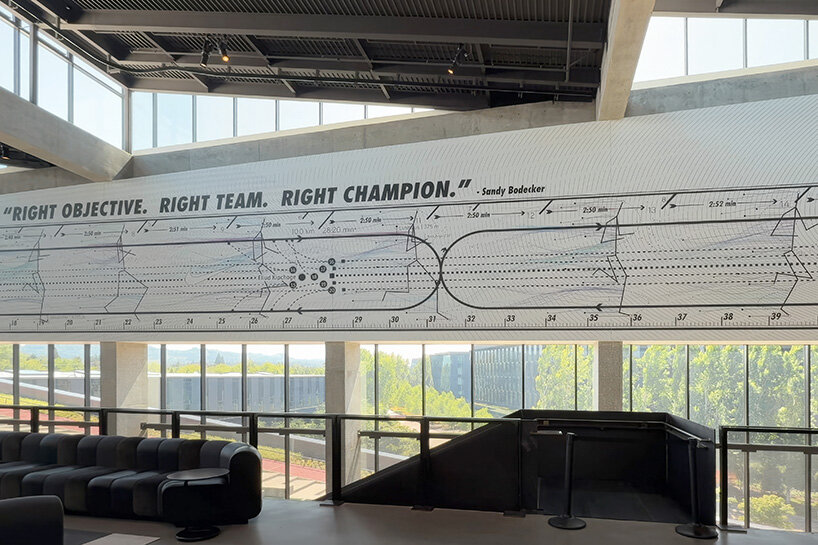
inside the NIKE Sport Research Lab | image © designboom
the aerodynamic ‘system of speed’
Once the team’s goal has been structured, NIKE’s footwear and apparel teams begin develop possible solutions. For Faith Kipyegon’s attempt at the sub-four minute mile, those solutions took form as a fully customized NIKE Victory Elite FK spike, a performance FlyWeb Bra, and the aerodynamically tuned NIKE Fly Suit, each built with attention to functionality and sensory experience together.
Lisa Gibson oversees apparel development at NIKE, and described the suit as one of the most aerodynamic systems the brand has created. ‘We learned that Faith wanted to feel like she was running free,’ Gibson emphasizes. That simple idea, freedom of movement, became a central design thread. From there her team sourced materials that were both slick and elastic, then developed construction techniques that placed seams away from the front of the body to reduce drag. Every detail was calibrated through a combination of physical modeling, wind tunnel testing, and environmental simulations.
Integrated into the suit are textured surfaces known as Aeronodes. These small, raised geometries are tuned to generate controlled turbulence, helping the air stay closer to the body and minimizing the wake behind the runner. ‘By creating this controlled turbulence ahead of where larger turbulence would normally occur,‘ Gibson continues, ‘you end up having a smoother flow downstream.’ The result is reduced aerodynamic drag without the need to alter the runner’s natural form.
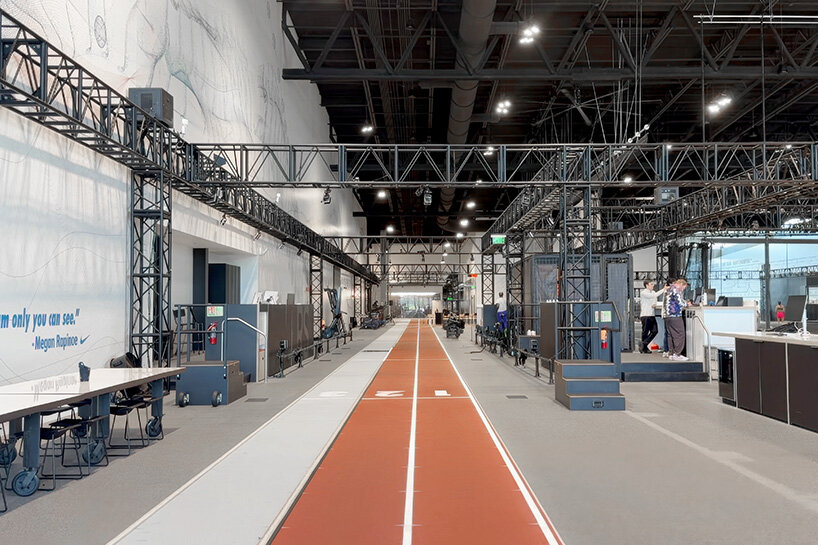
a running track threads through the colossal interior | image © designboom
a bespoke spike built from the ground up
Footwear innovation for the project is led by Carrie Dimoff, whose team approached the design of Faith’s Victory Elite FK spike as a ground-up reconstruction. Rather than modifying an existing shoe, they began by reviewing the demands of middle-distance racing and drawing insights from Nike’s experience with both marathon and sprint events. ‘We opened the aperture and looked at a lot of different ingredients,’ Dimoff tells us. ‘Then we thought about, ultimately, what’s the best in terms of weight reduction and performance return.’
The final spike includes a Flyknit upper constructed from precision-engineered yarns that deliver strength with minimal weight. Dimoff noted that one component of the upper weighs just three grams. Underfoot, a newly designed Air Zoom unit stores and returns energy, supported by a reengineered carbon plate embedded with six 3D-printed titanium pins for traction. Prototypes were assembled and revised on-site at the LeBron James Building in Oregon, allowing the team to respond to feedback from Kipyegon in real time.
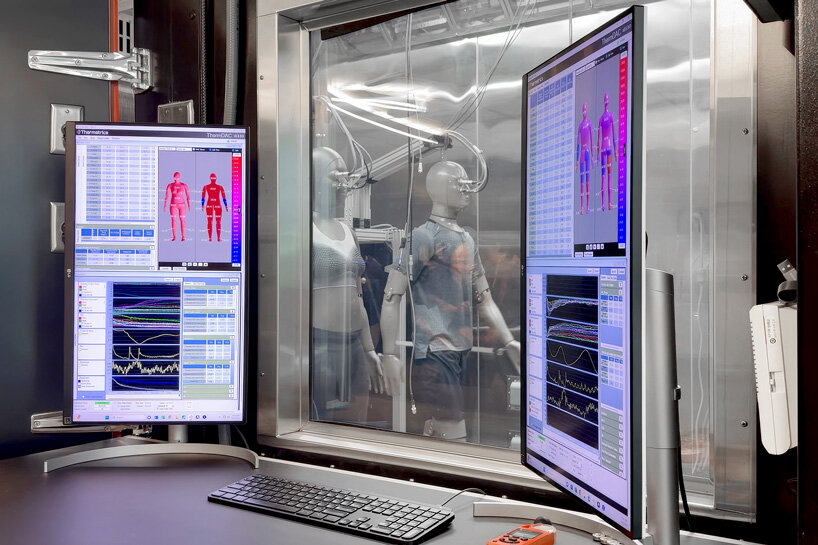
testing chambers measure sweat, body temperatures, and wind | image © designboom
Throughout the process, Kipyegon remained central to every decision. The design team traveled to Kenya to observe her training firsthand and make in-the-moment adjustments. Lisa Gibson recalled watching for what she called ‘unconscious feedback’ — the way an athlete might subtly adjust a seam or pull at a strap. ‘If Faith is tugging on the leg or adjusting the shoulder, that’s telling us something,’ she explains. ‘We dive into that and figure out what’s going on.’
Carrie Dimoff echoes this attentiveness. There were instances, she said, when internal lab data showed no significant difference between two prototypes, but Kipyegon could feel one worked better for her. ‘She is so attuned to her body as a system,” Dimoff said. “If it meant she could run more confidently in it, that was equally as important to us.’
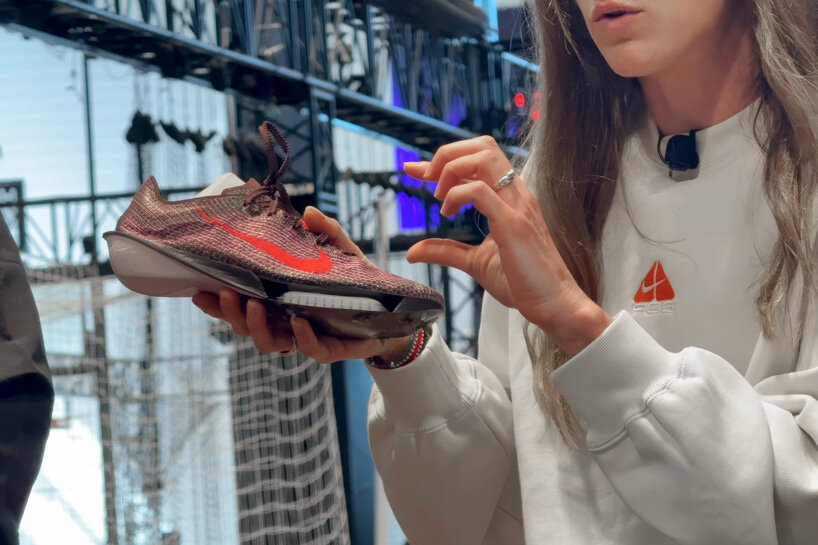
Carrie Dimoff shows Faith Kipyegon’s Breaking4 spike | image © designboom
While the gear developed for Faith Kipyegon’s Breaking4 attempt is entirely bespoke, the innovations produced through the project are already being evaluated for broader application. Elements such as the taller Air Zoom unit, 3D-printed pin systems, and even the textile learnings from the bra design are under review for integration into future footwear and apparel lines. ‘There were lots of things left on the table that didn’t make it into this spike,’ says Dimoff. ‘But we’re really fascinated to dig into them.’
What emerges from Nike’s collaboration with Kipyegon is at once a portrait of a singular athlete at the edge of possibility, and a case study in how design can be shaped by data, environment, sensation, and trust. The effort unfolds through textile calibration, surface tuning, and structured observation. In the end, the system is built from listening and innovation together.
-

 Health1 week ago
Health1 week agoOregon track star wages legal battle against trans athlete policy after medal ceremony protest
-

 NIL2 weeks ago
NIL2 weeks ago2025 NCAA Softball Tournament Bracket: Women’s College World Series bracket, schedule set
-

 Professional Sports1 week ago
Professional Sports1 week ago'I asked Anderson privately'… UFC legend retells secret sparring session between Jon Jones …
-

 College Sports2 weeks ago
College Sports2 weeks agoIU basketball recruiting
-

 Professional Sports1 week ago
Professional Sports1 week agoUFC 316 star storms out of Media Day when asked about bitter feud with Rampage Jackson
-

 Rec Sports2 weeks ago
Rec Sports2 weeks agoScott Barker named to lead CCS basketball • SSentinel.com
-

 Rec Sports2 weeks ago
Rec Sports2 weeks agoJ.W. Craft: Investing in Community Through Sports
-

 College Sports2 weeks ago
College Sports2 weeks agoOlympic gymnastics champion Mary Lou Retton facing DUI charge
-

 Motorsports2 weeks ago
Motorsports2 weeks agoNASCAR Penalty Report: Charlotte Motor Speedway (May 2025)
-

 Motorsports1 week ago
Motorsports1 week agoKalitta, Beckman & Hartford Win Mission #2Fast2Tasty Challenge at NHRA New England Nationals


